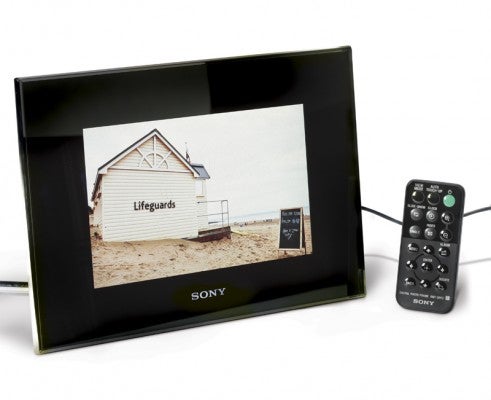The Sony DPF-X800 is one of two flagship models in Sony's new digital photo frame range, the other one being the larger 10in version, the DPF-X1000...
Sony DPF-X800 8in Digital Photo Frame
The Sony DPF-X800 is one of two flagship models in Sony’s new digital photo frame range, the other one being the larger 10in version, the DPF-X1000.
When Sony announced its new range of digital photo frames we expected a few minor tweaks. After all, why mess with a best-selling product range that already offers the best quality and functionality on the market? But, not wanting to rest on its laurels, Sony has introduced some technology to its new X Series range that offers a quantum leap in picture quality over even its own current range.
With existing frames there is a small gap between the back of the facia glass and the LCD panel which produces internal reflections. Though you don’t really notice them, the end result is a loss of contrast and colour saturation. Sony’s new TruBlack technology removes this sliver of air, and in doing so eliminates the reflections. Comparing the X800 frame, which boasts TruBlack technology, side by side with its predecessor, the difference in contrast and colour saturation is dramatic. It’s akin to turning a polarising filter on your camera lens on a sunny day and watching the colours pop in the viewfinder.
The X800 also boasts other new features, including face detection, which automatically optimises portraits for the skin tones, and a search facility to make it easier to locate specific pictures of events. There is also a limited menu of on-board retouching tools including redeye removal, exposure and white balance correction, sharpening, ‘skin smoothing’ and auto-dodging.
As you’d expect, the DPF-X800 offers slots for all the major media card types, as well as USB, and boasts an HDMI slot so you can connect it to your Sony Bravia or, (cough), other brand of flatscreen TV and view the slideshow at lifesize in full HD. (Most new Bravias have a PhotoTV HD mode that optimises the images for display.) There is also 2GB of memory built-in, enabling you to store up to 4,000 images on the frame at 2MP resolution.
Using a similar Bionz processor to that found in its DSLRs, the X800 can display even large image files quickly, including Raw files from Alpha DSLRs, and an auto orientation sensor turns them all the right way for you. One of the nice things about the Sony is that you can stand it up either vertically or horizontally and the pictures will flip accordingly.
Like Sony’s previous frames, if you’re displaying portrait images with the frame in landscape format, or vice versa, the remaining blank space can be filled with a classy-looking clock or calendar display – in stark contrast to many of the low-rent superimposed digital clock displays on some other frames. In fact, there are many other display options on the X800, including a variety of dissolve styles.
New to Sony frames is the ability to also wall mount the X800, though you’d still have the trailing power cables to contend with and there is as yet no battery option.
The X800’s green credentials are boosted with the inclusion of an auto-dimmer that reduces the screen brightness in lower light, and a timer so you can set it to switch itself off at night or when you’re at work. There’s also an alarm clock so it can wake you up.
Considering that Sony’s digital photo frames are already the best on the market, the DPF-X800 leaves its competitors even further behind. Their only consolation is that the X series frames are quite expensive – £220 for the 8in and £300 for the 10in – for that kind of money, you could almost buy an entry-level Bravia TV.





